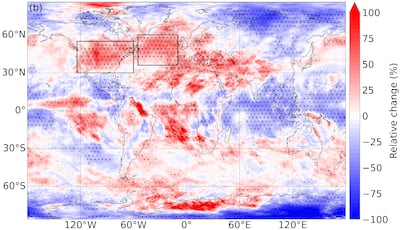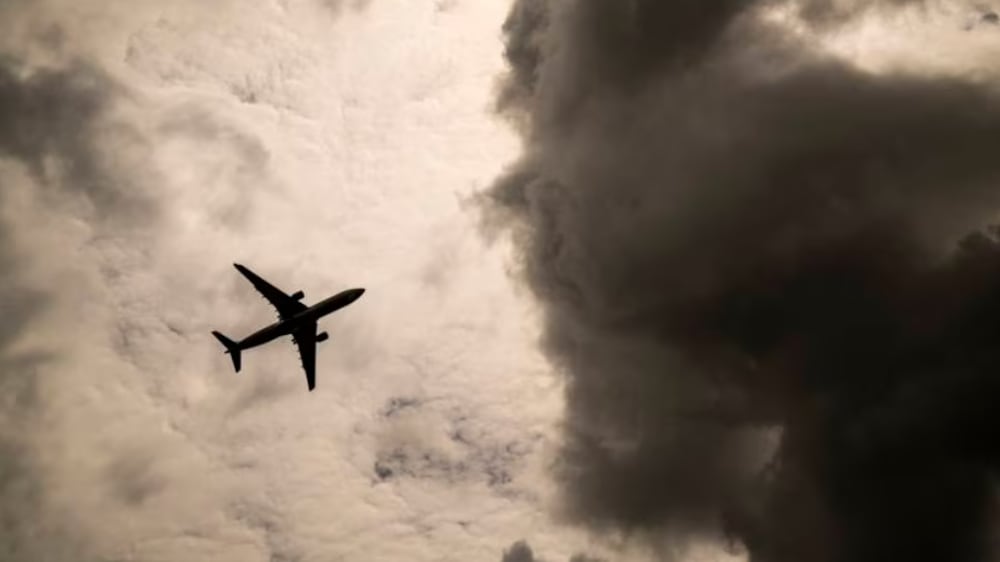Turbulence has increased in response to climate change, a new study has revealed.
Clear-air turbulence, a phenomenon invisible but dangerous to aircraft, has intensified significantly worldwide in the past four decades, researchers have found.
The study by the University of Reading revealed substantial increases in turbulence over busy flight routes across Europe, the Middle East and the South Atlantic, as well as surges over the US and North Atlantic.
Taking into account one of the world's busiest flight paths over the North Atlantic, the researchers observed the annual duration of severe turbulence increased by 55 per cent, from 17.7 hours in 1979 to 27.4 hours in 2020.

Moderate turbulence rose by 37 per cent, while light turbulence increased by 17 per cent over the same period.
Researcher Mark Prosser told The National “The Middle East and North Africa have experienced a relatively high increase over the past 40 years. The main geographical areas our study highlights are the continental US and the North Atlantic.
“Turbulence makes flights bumpy and can occasionally be dangerous,” Mr Prosser explained.
“Airlines will need to start thinking about how they will manage the increased turbulence, as it costs the industry $150 million to $500 million annually in the USA alone.
“Every additional minute spent travelling through turbulence increases wear and tear on the aircraft, as well as the risk of injuries to passengers and flight attendants,” Mr Prosser said.
The increase in turbulence is aligned with the effects of climate change, the research team said.
Prof Paul Williams, an atmospheric scientist at the University of Reading and co-author of the study, proposed a proactive approach.
“We should be investing in improved turbulence forecasting and detection systems, to prevent the rougher air from translating into bumpier flights in the coming decades,” Prof Williams said.
The impact of climate change on turbulence: A simple explanation
Mr Prosser said that the warming of the planet has affected the winds of the Northern Hemisphere jet stream over the North Atlantic.
This change has increased the likelihood of more clear-air turbulence.
Jet streams are fast-flowing air currents that move from West to East in the upper atmosphere. These are typically used by planes travelling in the same direction to save fuel and reach their destinations faster.
Mr Prosser said climate change had increased the temperature difference between the pole and the equator over the North Atlantic.
This increase intensifies the vertical wind shear of the jet stream, meaning the change in the speed of west-to-east winds becomes more pronounced with altitude, thereby boosting the chance for clear-air turbulence, he said.
The impact on airlines and passengers
According to Mr Prosser, the severity of turbulence determines the potential dangers and risks associated.
He told The National: “Taking the North Atlantic for example, light turbulence (slight bumpiness felt by passengers) has increased by 17 per cent (466.5 hours to 546.8 hours) and severe turbulence (high risk of physical injury if not strapped in) increased by 55 per cent from 17.7 hours in 1979 to 27.4 hours in 2020.
“In these regions, clear-air turbulence is more frequent and more severe than it was 40 years ago.”

Light turbulence might be a minor issue, but severe pockets could result in injuries and hospitalisation if passengers aren't wearing seat belts.
Mr Prosser said the best approach is for passengers to stay strapped in to avoid possible injuries.







